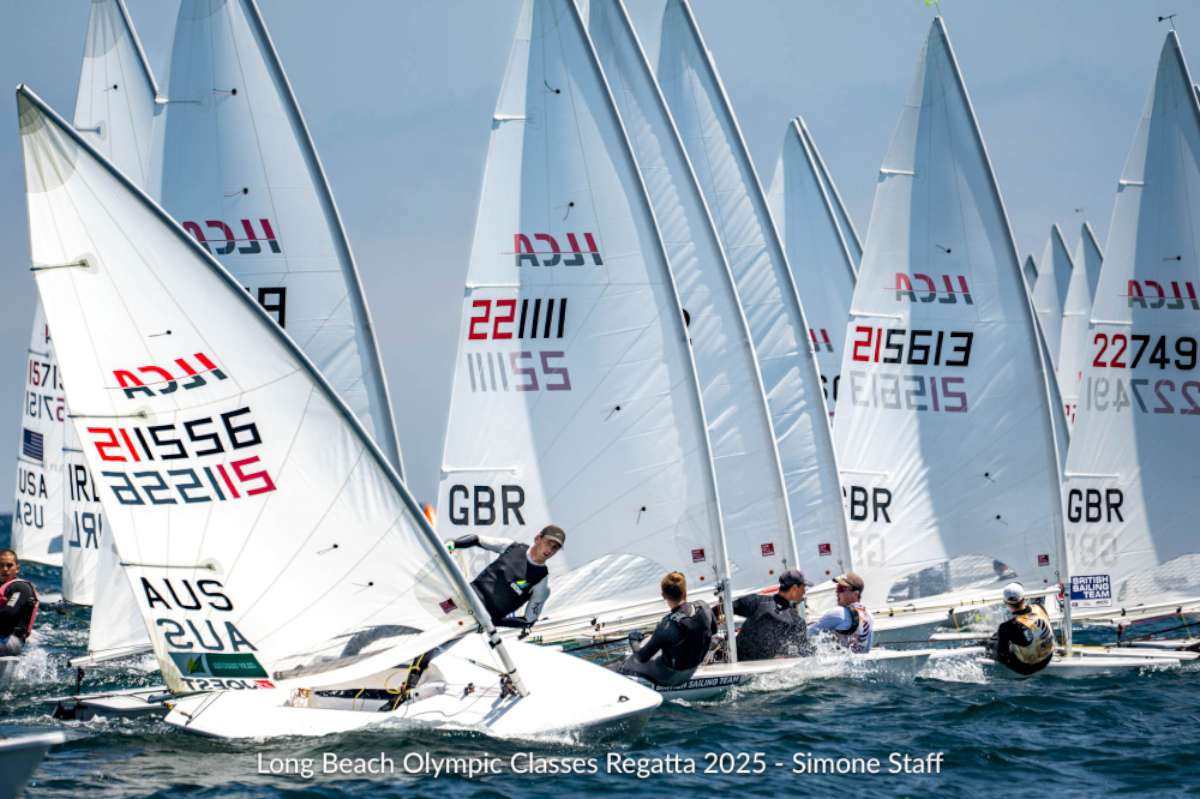Headsails
Reefing gear continues to develop so real gains can be had by checking out the latest systems. The greater efficiency of the new technology has allowed systems to be adopted by larger yachts, racing boats and, of course, cruisers.
Headsail furlers (which are not intended to reef) are also used on short-handed racing jibs, and increasingly on free-flying headsails generally. Headsail reefing gear has underpinned the growth of short-handed cruising and racing in ever-larger yachts. There are significant engineering differences between existing models, but diagram #1 shows the main features of a typical headsail.
Components
Bearings:One area where details differ is the highly loaded bearing in the drum and halyard swivel. Seals have a limited life, so most manufacturers now use combinations of plastic and/or stainless steel balls and races which are open to the air and water.
Hlyard Return Systems:Headsail reefers in which the halyard passes over a sheave at the top of the spar and returns inside or outside to be tensioned at the base (eg www.furlings.com) are simpler than those with swivels and don’t impose halyard loads on the mast, but tend to sag more because the stay provides lateral support against buckling by the combined luff and halyard tensions. There’s a version with a flexible one-piece PVC luff extrusion for stays up to 16m long (www.sailcdi.com). The double loading can be avoided by using a halyard catch at the top of the spar, tripped by a line from the bottom.
Reefing Pros n Cons
The advantages include easily and safely altering headsail area from the cockpit single-handed, incremental changes rather than discrete steps (without the delays and procrastination involved in a sail change) and on larger yachts the use of powered drives. Fewer headsails over all, and the ability to stow sails on the reefer also frees up space below.
Against this is the better windward performance of individual sails, and the possibility of mechanical problems leading to destruction of the sail or worse. The extra weight and windage aloft increases heeling at sea, and yawing at anchor, and the stay is not available for other sails better suited to very light or very strong winds. Sails and gear to circumvent this limitation have become common.
Flattening: The flatness of an initially large sail can be improved during reefing by gathering in more cloth from the middle of the luff than at the top and bottom. This is commonly done by sewing a double tapered foam pad about 5-10mm thick along the luff. There are also double swivel systems in which the tack and head attachments are free to rotate independently of the spar which produces some flattening.
Sails options
Most reefing headsails are at least the size of a No1 jib – so a bigger sail is needed for light winds, and at least the ability to set a storm jib for strong windward work. Permanent or temporary cutter rigging (tensioned when needed by a Hyfield lever and perhaps runners) provides an inner stay available for a conventional hanked stormsail, and on cruisers this is commonly fitted with a robust furler and a heavy weather sail. Permanent second headstays for hanked headsails are reasonably common but can lead to problems with chafe, tacking and tensioning. A temporary masthead stay attached very close to the reefer can serve for hanked drifters or light genoas.
Free-Flying: The trend even in cruising yachts is to carry asymmetrics (gennakers, reachers, MPS etc) for light downwind conditions, and furling is now also being applied to these free-flying sails that lack a tensioned luff. Balmar’s Rollgen, for example, have models in which the sail is hoisted together with a flexible synthetic stay of the appropriate length, via a swivel with an arm that prevents the upper part from rotating by bearing against the mast. Their stay is encased in a flexible rubber ‘tabling’ foil, but some smaller systems just use a braided rope. The head is attached to the swivel and rotates with the stay, as does the tack attached to the furler. Furling begins at the tack and head, and progressively wraps the bunt of the sail around the flexible stay.
Code Zero and others: Code Zero sails and equivalent cruising windward drifters have an integral luff rope, and are hoisted free, without hanking to a stay. Decking and bagging these big but fragile sails can be a problem. A spinnaker sock or snuffer may work, but Code Zero's with low-stretch braided luff ropes (eg Aramid ‘torque ropes’) allow the sail to be furled around its own luff. The resulting sausage is flexible enough to stow compactly, unlike wire-luffed furling sails of old. The head is hoisted with a halyard swivel, and on smaller yachts (or when deployed with an outhaul from bowsprits or even from poles with a downrigger) the tack is usually made fast to a furler then rotated by an endless rope drive. In most cases, the top of the swivel engages into a mast fitting, and the luff is tensioned by downloading beneath the drum. Some have locks in the mast fitting (with an unlock control line), reducing halyard compression of the mast. Karver, a company that specialises in gear for Ocean 60s and other large yachts, has a patented version in which the halyard itself is the lock control line (www.karver-systems.com) A furled sail can be temporarily left aloft (some drives have catches to prevent accidental unfurling), or dropped, detached from swivel, drive, and sheets, coiled and bagged.
The strong but flexible luff rope concept is being applied to other types of sail, especially in conjunction with sub-deck furlers, and given strong enough gear provides an alternative to removable stays, except perhaps for heavy-weather jibs.
Flush deck systems
Reefing systems near the stem-head must have their drum or motor above the deck, usually with clearance beneath for anchoring gear. If the gear is mounted further aft, it's possible to have the rotator below deck, with just the tack attachment (and spar) protruding. This is much neater even if the motor or drum is within the anchor locker, but with appropriate sealing can be even further aft. Manual versions with sub-deck endless rope drives are seen on some small racing craft. A further development combines a spherical deck joint with the sub-deck motor, eliminating the need for a chain plate beneath the motor and allowing it to self-align with the load.
Powered
Motors are commonly used on larger luxury yacht reefing and furling systems. Some incorporate an hydraulic stay tensioner, and even the sheet is sometimes controlled by a powered self-stowing captive winch. Hydraulics are generally preferable, but electric motors are available for smaller systems. A drawback of some powered systems is they lack a clutch, so the unfurling is slower than if the furler can unwind freely, responding to sail tension. A manual wind back-up is advisable.
MAINSAILS
Conventional Options:
Slab Reefing:Racing yachts and most cruising yachts still use slab or jiffy reefing because it allows the shape of the reefed sail to be controlled by adjusting tensions in the clew and halyard. Lazy jacks, full-length battens, rigid vangs, and on larger yachts powered self-tailers all help. Especially for short-handed reefing, but a practised crew with a good system can put in a reef in little more time than it takes to partly lower the sail and adjust the halyard.
Rolling boom:Roller boom reefing has a long history, and some experienced sailors still use it, including with manual or powered through-mast rotators that allow the operation to be conduced from the cockpit, provided the sail has a bolt rope luff.
Rolling booms are much slower on mainsails fitted with sliders because these don’t auto-feed when hoisting sail again, and their bulk builds up thickness at the forward end of the roll. Consequently, these systems generally have a worm or ratchet drive at the gooseneck, and the halyard winch nearby on the mast, so one person can progressively furl the sail by sequentially slackening a bit of halyard, and guiding the slider stowage while cranking the drive handle. Roller boom reefing requires a topping lift, and is incompatible with conventional vangs, boom brakes, lazy jacks, mid-boom sheeting, and cockpit control of outhaul tension. Even if the boom is tapered (fatter at the outboard end) to counteract drooping, the resulting sail shape is generally poor for windward work because there is no control over clew tension. To prevent the furled luff from obstructing the furling gear and gooseneck, the sail track is often curved aft away from the mast, but this too tends to increase the reefed sail’s bagginess near the boom.
In-boom reefing: Over the past 20 years or so most of the limitations of traditional rolling boom reefing have been overcome by systems in which the sail attaches to a rolling ‘mandrel’. Initially, the mandrel was supported above a conventional boom. This restored the ability to use vangs, boom brakes, lazy jacks and mid-boom sheeting. These days the mandrel is usually housed inside a larger boom with a slot at the top for the sail to pass through, so a sail cover isn’t needed.
The booms are made from a variety of materials ‘ aluminium, GRP, and carbon fibre, and there are many detail differences in the mechanisms. On smaller boats, the mandrel can be manually driven by endless rope drives just aft of the gooseneck, or by endless or stored rope drums at the front of the mast, driving through it with a universal joint at the gooseneck. Another variation (eg John Mast – Denmark) has the rope drum within the aft end of the boom, with the line leading forward to the mast and thence to the cockpit. On larger yachts, the drive may be electric or hydraulic, and is also sometimes within the boom or mandrel.
All systems use bolt-roped mainsails which feed automatically as the halyard is raised ‘ in some cases the luff is cut with an undulation so it feeds itself back and forth slightly as it rolls onto the mandrel, reducing thickness build-up.
Some involve a metal or plastic adapter extrusion between luff groove and mast groove, especially in the section immediately above the feeder, or to retrofit to a mast with a track for T-sliders.
Most systems use full-length battens which help keep the foot tensioned, but some brands have additional features intended to contribute to sail shape – Furlboom, for example, has a system that deflects the mandrel downward as reefing progresses, helping to flatten the sail. Some extend the track aft from the mast for some distance above the feed point (as was done with conventional rolling boom reefing), to encourage the luff to roll aft of the gooseneck.
John Mast’s HiLow Reefer runs a parallel track extension all the way to the mast head, with an in-fill piece in between. Profurl also step the extension well aft of the mast, but leave a slot between, and yet another approach is to have the furling mandrel above the gooseneck, so no extension is needed.
In-boom reefers are increasingly popular in larger leisure yachts, where the weight and extra cost is acceptable for the convenience that it brings. As with roller-reefed headsails, in-boom reefing is a compromise between convenience and sail shape, but if the sail has reef cringles and appropriate attachments are on the boom, it may be possible to revert to slab reefing if really necessary.
Vertical mainsail reefers
The other approach is to rotate mainsails about a vertical spar, similar in principle to a headsail furling system. The mainsail is loose footed and its clew is usually controlled via a car running along the boom. They are incompatible with horizontal battens, but some use vertical battens to support a roach and improve the shape of the sail.
Behind mast: The simplest are essentially a headsail reefer on a stay tensioned between the mast crane and deck, through or just forward of the gooseneck. The stay imposes additional eccentric compressive load on the mast, and does tend to sag away from it. This can be only partially counteracted by the initial cut of the luff, and a padded luff for reefing. A leech sun-cloth protects the furled sail. This system may interfere with setting a storm trysail.
In-mast:There are two forms ‘ those having the mast built with an almost circular partitioned cavity to house the furling spar and sail (and exit slot) ‘ and add-on extrusions with the same internal arrangements but riveted to the back of the mast. The slot for the sail exit is smaller than the spar’s diameter, which physically limits luff sagging. The extrusion may incorporate a storm trysail track, and provision for hoisting a blanking strip to exclude sunlight and wind noises.
Most manual systems use stored rope ‘worm screw’ drives which like some electric drives (with permanent magnet)
Overview
In-mast systems are neat and quick to operate, and like in-boom furling are often used to provide push-button furling and off-the wind reefing on prestigious brand-name yachts. Mechanically, in-mast is simpler, faster and doesn’t require the sail weight to be hoisted. On the other hand, the sail cannot be dropped once furling has commenced (motorised systems should have a manual back-up), the spar may clang against the housing, and the mast may have to be unstepped to access the spar. In-mast systems also add more weight aloft, and the consequences of a jam are potentially more serious. Neither type allows the control of sail flatness available in slab reefing, but most yachts fitting them also have powerful engines to provide additional windward drive.
Large one-off racing and luxury yachts often incorporate interesting new developments. Take Mirabella V's traditional white furling headsails, for example. Her Bluewater Weave fabrics have a woven Vectran core, laminated to an off-axis scrim, and then coated both sides with a white UV and abrasion-protective layer that can be top-coated annually. Stronger, thinner, and lighter sailcloths reduce weight and windage aloft, and the diameter of the furled sail.
























